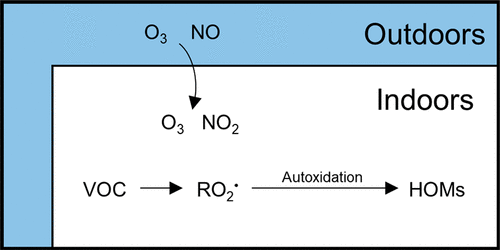当前位置:
X-MOL 学术
›
Environ. Sci. Technol. Lett.
›
论文详情
Our official English website, www.x-mol.net, welcomes your
feedback! (Note: you will need to create a separate account there.)
Autoxidation of Limonene Emitted in a University Art Museum
Environmental Science & Technology Letters ( IF 8.9 ) Pub Date : 2019-08-21 , DOI: 10.1021/acs.estlett.9b00425 Demetrios Pagonis 1, 2 , Lucas B. Algrim 1, 2 , Derek J. Price 1, 2 , Douglas A. Day 1, 2 , Anne V. Handschy 1, 2 , Harald Stark 1, 2, 3 , Shelly L. Miller 4 , Joost A. de Gouw 1, 2 , Jose L. Jimenez 1, 2 , Paul J. Ziemann 1, 2
Environmental Science & Technology Letters ( IF 8.9 ) Pub Date : 2019-08-21 , DOI: 10.1021/acs.estlett.9b00425 Demetrios Pagonis 1, 2 , Lucas B. Algrim 1, 2 , Derek J. Price 1, 2 , Douglas A. Day 1, 2 , Anne V. Handschy 1, 2 , Harald Stark 1, 2, 3 , Shelly L. Miller 4 , Joost A. de Gouw 1, 2 , Jose L. Jimenez 1, 2 , Paul J. Ziemann 1, 2
Affiliation

|
The lifetime of alkylperoxy radicals (RO2•) formed in the oxidation of volatile organic compounds (VOCs) is a key determinant of reaction mechanisms and products. When RO2• radical lifetimes are long, autoxidation reactions can form highly oxidized multifunctional compounds (HOMs) that are efficient at forming secondary organic aerosol (SOA). We measured the formation of HOMs resulting from the O3-initiated autoxidation of limonene emitted inside the University of Colorado Art Museum. Conditions inside the museum favored autoxidation for most of the 6-week study, indicating that autoxidation is prevalent indoors in the absence of an indoor combustion source of nitrogen oxide (NO). A box model of the museum was used with measurements of VOCs, O3, and NOx and air exchange to estimate HOM and SOA yields and to model the limonene oxidation rate. The HOM molar yield of 11% agrees well with the results of laboratory studies of limonene autoxidation, and the SOA mass yield of 47 ± 8% indicates that limonene autoxidation efficiently forms SOA indoors.
中文翻译:

大学美术馆散发的柠檬烯的自氧化作用
挥发性有机化合物(VOC)氧化形成的烷基过氧自由基(RO 2 •)的寿命是反应机理和产物的关键决定因素。当RO 2 •自由基寿命长时,自氧化反应会形成高度氧化的多功能化合物(HOM),可有效形成二次有机气溶胶(SOA)。我们测量了由O 3引起的HOM的形成引发的科罗拉多大学美术馆内放出的柠檬烯的自氧化。在为期6周的研究中,大部分时间里博物馆内的条件都有利于自氧化,这表明在没有室内燃烧氮氧化物(NO)燃烧源的情况下,室内普遍存在自氧化作用。博物馆的箱型模型用于测量VOC,O 3和NO x以及进行空气交换,以估算HOM和SOA的产率并模拟li烯的氧化速率。11%的HOM摩尔产率与柠檬烯自氧化的实验室研究结果非常吻合,SOA的质量产率为47±8%,表明柠檬烯自氧化在室内有效地形成了SOA。
更新日期:2019-08-21
中文翻译:

大学美术馆散发的柠檬烯的自氧化作用
挥发性有机化合物(VOC)氧化形成的烷基过氧自由基(RO 2 •)的寿命是反应机理和产物的关键决定因素。当RO 2 •自由基寿命长时,自氧化反应会形成高度氧化的多功能化合物(HOM),可有效形成二次有机气溶胶(SOA)。我们测量了由O 3引起的HOM的形成引发的科罗拉多大学美术馆内放出的柠檬烯的自氧化。在为期6周的研究中,大部分时间里博物馆内的条件都有利于自氧化,这表明在没有室内燃烧氮氧化物(NO)燃烧源的情况下,室内普遍存在自氧化作用。博物馆的箱型模型用于测量VOC,O 3和NO x以及进行空气交换,以估算HOM和SOA的产率并模拟li烯的氧化速率。11%的HOM摩尔产率与柠檬烯自氧化的实验室研究结果非常吻合,SOA的质量产率为47±8%,表明柠檬烯自氧化在室内有效地形成了SOA。










































 京公网安备 11010802027423号
京公网安备 11010802027423号